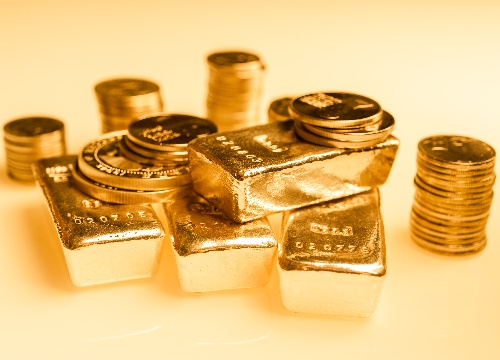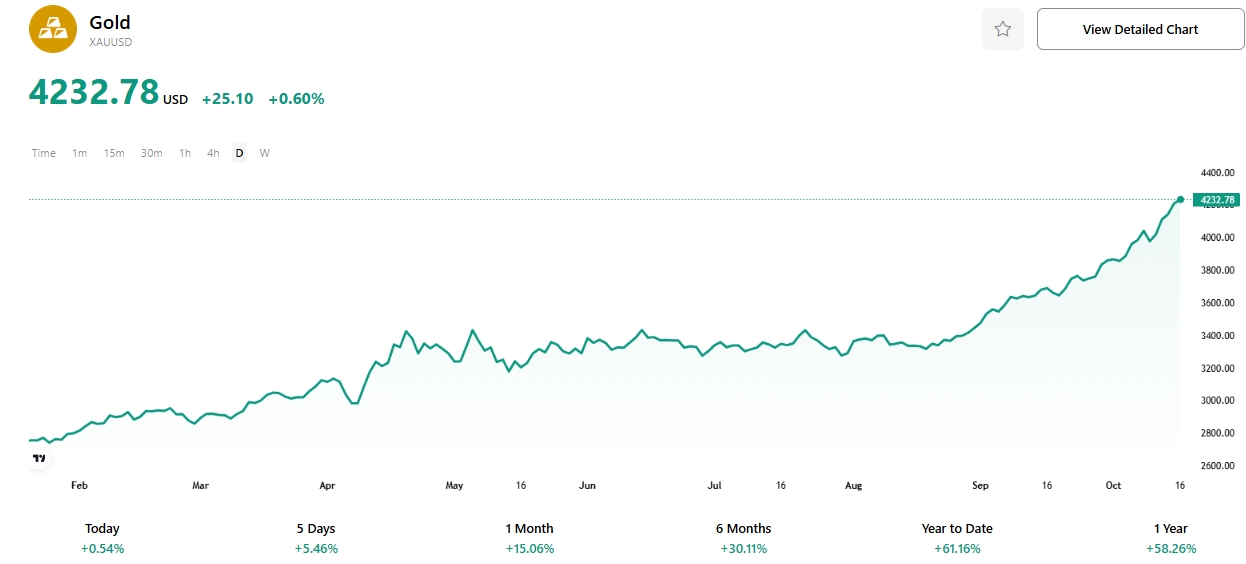When Will Record-Breaking Gold Top Out? Hold It Like Insurance, Analysts Say

TradingKey - As of October 16, gold prices have risen for six consecutive days, with gains in nine out of the first ten months of 2025. The market often attributes gold’s relentless rally — now at fresh all-time highs — to U.S. policy volatility and rising non-dollar demand abroad. But some argue this is backward reasoning. The real driver, they say, is simpler: insurance.
At the time of writing, gold rose 0.60% on the day to $4,232.78 per ounce, having broken the historic $4,200/oz level the previous day. Year-to-date, gold is up a staggering 60%.

Gold Price Hits New High, Source: TradingKey
Despite such massive gains, there are still no significant bearish positions forming in global markets.
At a Fortune summit on Wednesday, JPMorgan CEO Jamie Dimon, who has warned of elevated valuations across nearly every asset class, acknowledged that holding gold feels “semi-rational” in today’s environment.
“It could easily go to $5,000, $10,000 in environments like this,” Dimon said.
Notably, Dimon added that this is one of the few times in his life it’s semi-rational to have some in the portfolio.
Beyond Debasement Trade — The “Insurance” Narrative
Wall Street has framed gold’s surge as part of the “debasement trade” — investors rotating into gold and Bitcoin to hedge against inflation, dollar weakness, Fed independence concerns, Trump’s tariff policies, and rate cuts.
But John Stepek, Bloomberg columnist, argues that no one really knows why gold keeps going up.
He points to George Soros’ theory of reflexivity: bull markets create their own narratives — where cause and effect reinforce each other, making it hard to tell which came first.
Stepek offers a more intuitive explanation:
“Gold is insurance.”
Gold acts as portfolio protection against systemic risk. When trust in other assets wavers, gold re-enters the picture — not because it’s expected to deliver outsized returns, but because it provides certainty in uncertain times.
Today’s mix of geopolitical instability, intensifying U.S.-China rivalry and unknown disruptions from AI may not be outright “bad,” but in an environment of uncertainty, people crave stability and safeguards. Gold delivers exactly that.
Capital Is Questioning the Dollar
JPMorgan analysts note that recent financial trends suggest trust in U.S. assets is eroding. The U.S. is increasingly vulnerable to capital flight if foreign investors seek alternatives.
They project that if just 0.5% of foreign-held U.S. assets were reallocated into gold, the price could reach $6,000/oz by 2029.
No Top in Sight — A New Asset Allocation Paradigm
Guosen Securities maintains a bullish outlook, emphasizing gold’s role in diversification and risk hedging. They argue it’s still too early to call a top.
The firm recommends:
Households: Allocate 2–10% to gold for risk diversification
Institutions: Hold over 10% in gold to enhance portfolio resilience
This marks a shift in investment philosophy — from the old “fixed income +” model to a new era of “gold +” portfolio construction.
* The content presented above, whether from a third party or not, is considered as general advice only. This article should not be construed as containing investment advice, investment recommendations, an offer of or solicitation for any transactions in financial instruments.


